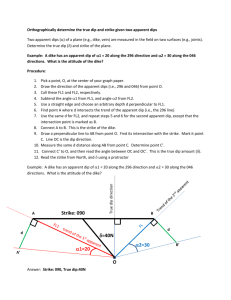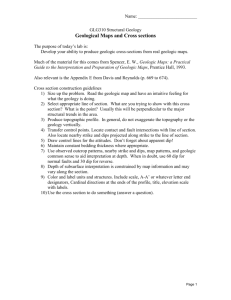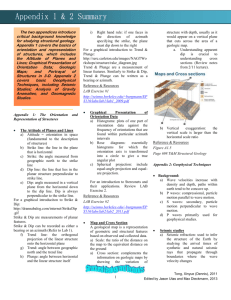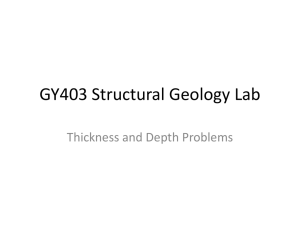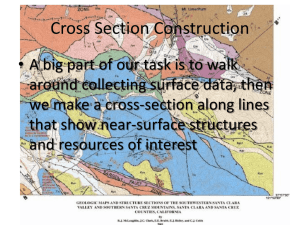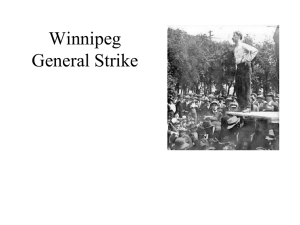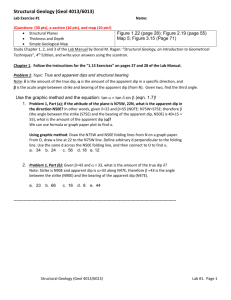Orthographic Projection
advertisement
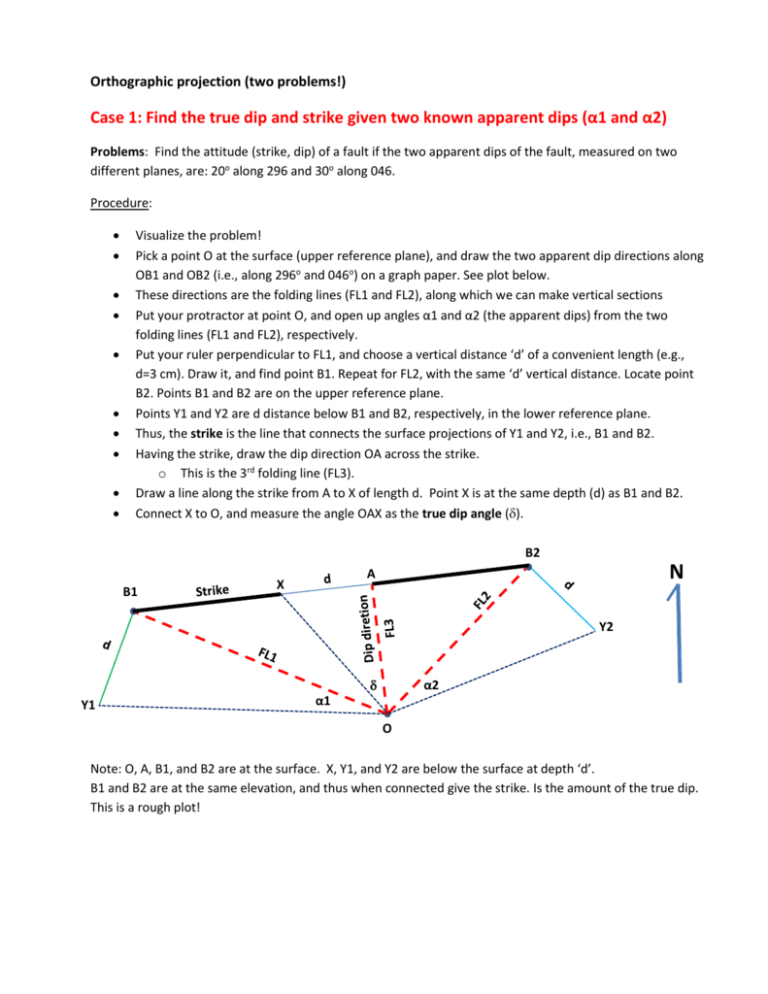
Orthographic projection (two problems!) Case 1: Find the true dip and strike given two known apparent dips (α1 and α2) Problems: Find the attitude (strike, dip) of a fault if the two apparent dips of the fault, measured on two different planes, are: 20o along 296 and 30o along 046. Procedure: Visualize the problem! Pick a point O at the surface (upper reference plane), and draw the two apparent dip directions along OB1 and OB2 (i.e., along 296o and 046o) on a graph paper. See plot below. These directions are the folding lines (FL1 and FL2), along which we can make vertical sections Put your protractor at point O, and open up angles α1 and α2 (the apparent dips) from the two folding lines (FL1 and FL2), respectively. Put your ruler perpendicular to FL1, and choose a vertical distance ‘d’ of a convenient length (e.g., d=3 cm). Draw it, and find point B1. Repeat for FL2, with the same ‘d’ vertical distance. Locate point B2. Points B1 and B2 are on the upper reference plane. Points Y1 and Y2 are d distance below B1 and B2, respectively, in the lower reference plane. Thus, the strike is the line that connects the surface projections of Y1 and Y2, i.e., B1 and B2. Having the strike, draw the dip direction OA across the strike. o This is the 3rd folding line (FL3). Draw a line along the strike from A to X of length d. Point X is at the same depth (d) as B1 and B2. Connect X to O, and measure the angle OAX as the true dip angle (). B2 B1 N A X Y2 Y1 α2 α1 O Note: O, A, B1, and B2 are at the surface. X, Y1, and Y2 are below the surface at depth ‘d’. B1 and B2 are at the same elevation, and thus when connected give the strike. Is the amount of the true dip. This is a rough plot! Orthographic projection Case 2: Determine the apparent dip (α) along a specific direction, at an angle of to the strike, given the strike and true dip (). Problem: If the true dip () is 36o N (i.e., strike is E-W), what is the apparent dip (α) along a section that is at 30o to the strike (i.e., = 30o)? Approach: B A strike A d Y A strike α d X N FL1 Pick a point ‘O’ in the middle of your graph paper. Plot the strike line along E-W through point ‘O’. See plot below. Draw a line OA, perpendicular to the strike, to represent the true dip direction o Note: Points O and A are in the same level (i.e., on the upper reference plane) o Let’s cut a section along the true dip direction (along the FL1 folding line) o Since the true dip () is given, open up the angle from OA. o Put your ruler perpendicular to OA, and choose a convenient depth scale ‘d’ below A (say 2 or 3 cm) perpendicular to the FL (i.e., along the strike). Find X. o OAX is a vertical section rotated to the surface along FL1! o Point A is at the surface. Point x is at depth d below point A. Draw a line along the direction (in this case at 30o to the strike because = 30) which we want to calculate the apparent dip. Pick a point B where this line intersects the strike line at the A level. Points O, A, and B are all in the same (top surface) level. o Line OB is a folding line (FL2). We will cut along this line. o Put your ruler perpendicular to the FL2, and go d distance down below the surface, Find Y. Note: Points X and Y are in the same level (i.e., in the lower reference plane, d distance below points O, A, and B). o OBY is a vertical cross section which is rotated to the surface along FL2. Connect point y to O. The angle BOY gives the apparent dip (α). Read it with a protractor (20o). Dip direction =36 O =36 This is a rough plot!
